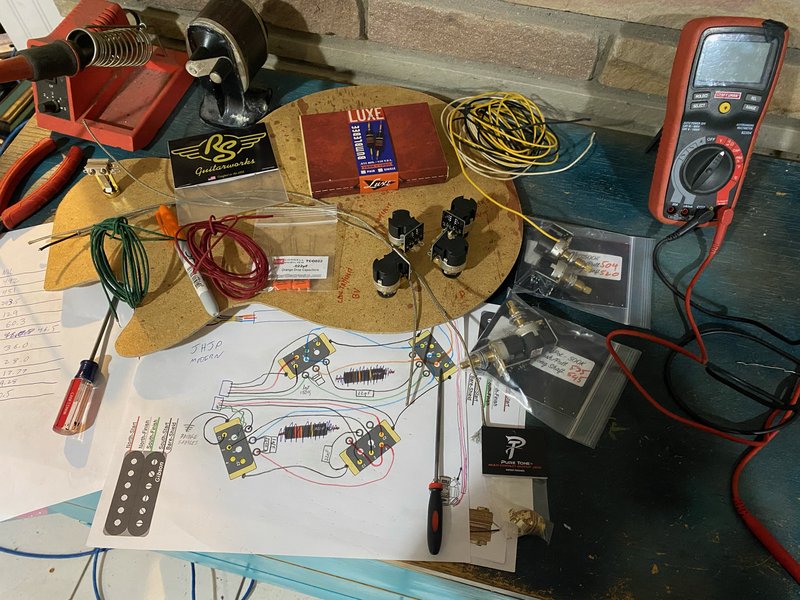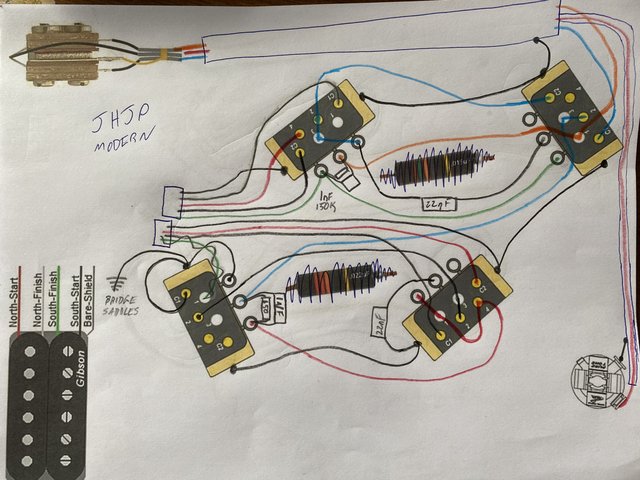|
|
Post by airistubolis on Mar 1, 2021 22:41:20 GMT -5
|
|
|
|
Post by newey on Mar 2, 2021 6:35:12 GMT -5
I have all the supplies to do 2 harness. I was thinking a 50’s version and a modern version. Why build two harnesses? Pick one that you want and build that one. First off, not all of these diagrams are '50's style wiring. The first 3 are apparently from various pickup manufacturers and are the standard Jimmy Page wiring as far as I can tell. The fourth diagram is from our own JohnH. It looks like you found that copy on a site called "guitarwiring.pptx". I have no idea whether JohnH has given them permission to repost his work or not, or whether they even attribute the diagram to JohnH, but shame on them if they didn't. JohnH's version uses modern wiring, not '50s. JohnH also "tidied up" the positions of the controls a bit, and he uses the phase switch to also select the opposite coil when the coil cut switch is also pulled up, so that both in-phase and out-of-phase single-coil settings are hum-cancelling. Same thing with the 4th one down, which JohnH redrafted from an idea of one of our long-ago members, borsanova. (That one even bears a copyright symbol!). Borsanova's version differs in that he has the bridge tone pot push/pull used to put the 2 coils of the bridge HB in series/parallel, and when the neck coil-cut switch is also pulled up with the bridge series/parallel, then the bridge pickup cuts to single coil. So, this differs somewhat from a classic "Jimmy Page wiring". I don't know about the 5th diagram, it's too small to see and I can't enlarge it. The differences here are fairly minor, excepting Borsanova's scheme. Before you decide that you want '50's wiring, read JohnH's exposition of the differences here. Note also that the differences between modern and '50's wiring only come into play as the tone pot is turned down- with the tone pots dimed, you won't hear any difference between the two wirings. If you decide to use modern wiring, JohnH's version of the JP cleans up some issues with Page's original and I would prefer that one. If you decide that you want '50's wiring (for which I've never understood the attraction, maybe I'm biased), any of the first three diagrams will do that for you. You will, of course, have to translate wire colors depending on what pickups you use. As far as which gives the most "useful set of options", Borsanova's scheme gives the added option of series/parallel for the bridge HB, with the downside that you then have to pull 2 switches to get the bridge coil-cut. But this means that the neck SC- bridge HB combo (with the neck cut to single coil but the bridge in series HB)is possible, which the std JP wiring doesn't do. |
|
|
|
Post by JohnH on Mar 2, 2021 7:27:22 GMT -5
I think this is a collection from a PowerPoint file? (.pptx) No problem. I like my one! But actually, for my own use, I got to the point on other guitars that I dont really like using push-pull pots. Too fiddly for me! I like the feel of a simple full size pot. it's just a personal view. So when I got a decent Gibson LP I used standard pots, and got my series, phase and coil cut settings in different ways using the tone pots and switches behind the toggle. I still like it a decade later. guitarnuts2.proboards.com/thread/4571/humbuckers-lp-modular-wiring-design |
|
|
|
Post by airistubolis on Mar 2, 2021 11:33:21 GMT -5
 guitarnuts2.proboards.com/thread/8884/hh-guitars guitarnuts2.proboards.com/thread/8884/hh-guitarsThis one intrigues me most. I can make the switch. 1. move controls to traditional locations. Optional 2. add treble bleed. 3. what else can be updated. 4. what if anything does this gain/loss vs Others |
|
|
|
Post by newey on Mar 2, 2021 12:55:24 GMT -5
The only difference between this scheme of Phostenix's is that the modified 3-way switch allows the center position of the 3-way to operate in either series or parallel, while flipping the switch to neck or bridge side gives that pickup alone.
As Phostenix points out, without the special switch, the series/parallel switchcan be wired two ways- first, it can be wired such that it overrides the 3-way, meaning that pulling up on the series/parallel switch will put both pickups in parallel regardless of the position of the 3-way switch. If you have both pickups in series, and you want to switch to neck alone, you have to manipulate both the P/P and the 3-way switch, unless the three-way switch is already set to the neck position.
The other way is that, as typically wired, the series setting only works when the 3-way switch is set to the neck position- if the series P/P is pulled up with the 3-way switch in either the center or bridge position, you will get the bridge pickup by itself.
But also note that Phostenix's diagram, like JohnH's, has the tone controls wired in the modern fashion, not '50's style.
|
|
|
|
Post by airistubolis on Mar 2, 2021 13:29:58 GMT -5
I always wanted to try 50’s wiring. And I want to do a modern setup with treble bleed and hear it myself.  |
|
|
|
Post by airistubolis on Mar 2, 2021 13:35:40 GMT -5
I was filling some carbon off the resistor in one of the pots to get it from 471 to 537 and got a little over zealous and ended up at 580. Oops.
|
|
|
|
Post by airistubolis on Mar 2, 2021 14:02:05 GMT -5
For a 2015 Epiphone Les Paul Custom Pro with 5 pin quick connects CTS pots  |
|
|
|
Post by frets on Mar 2, 2021 15:08:01 GMT -5
I was filling some carbon off the resistor in one of the pots to get it from 471 to 537 and got a little over zealous and ended up at 580. Oops. Hi Air😺, That pot will just be brighter. I’d probably use it as the tone pot on the neck. Too bright, add another cap in parallel. Start out low like a 4.7nF. I’m sure the other guys will have some thoughts. Those are just my thoughts. I see your using Bees, if they’re original 50’s bees they’re probably running higher in nF’s so you might not notice any difference with that pot. Pots are rarely ever on 500k. They all vary. No big deal. |
|
|
|
Post by airistubolis on Mar 2, 2021 20:53:24 GMT -5
|
|